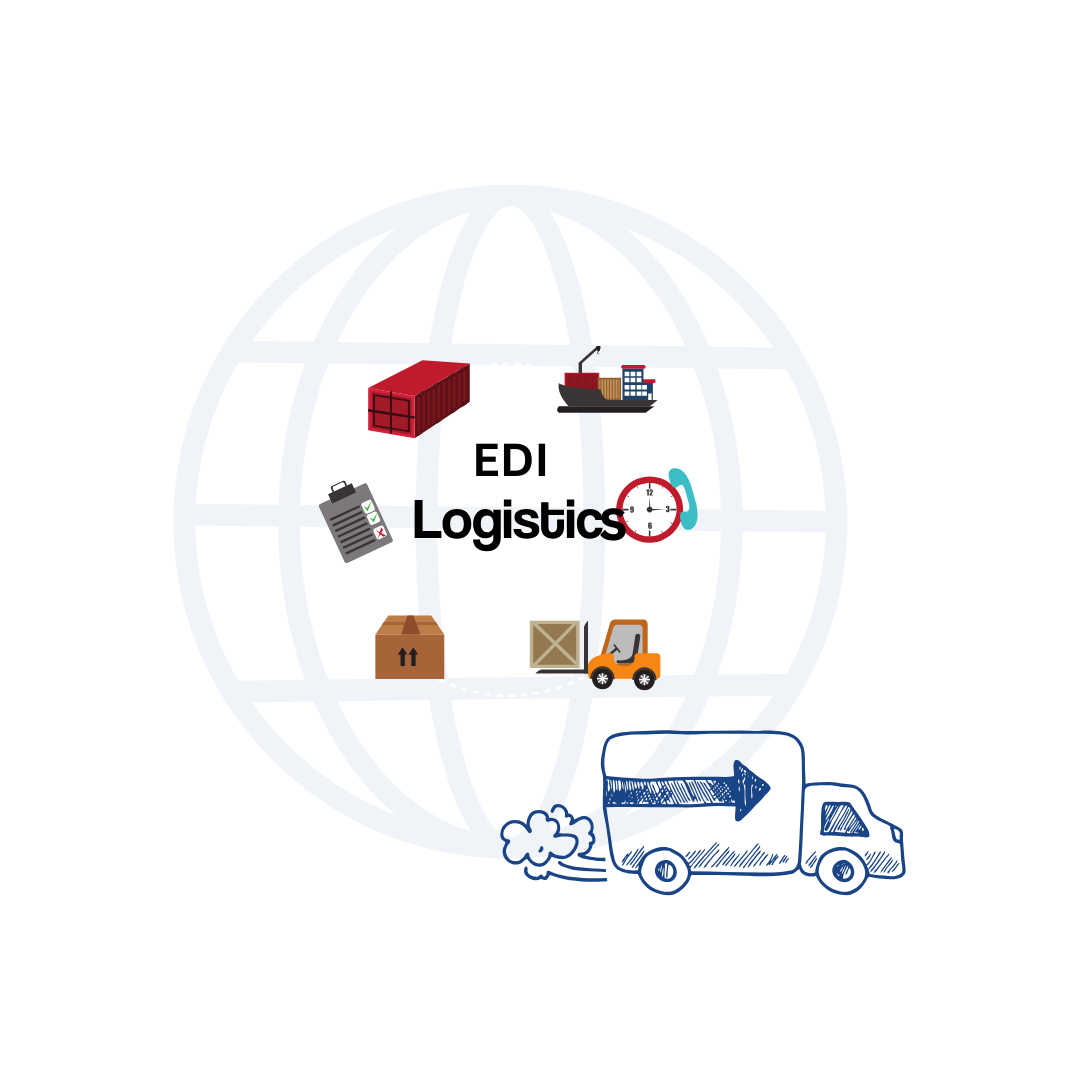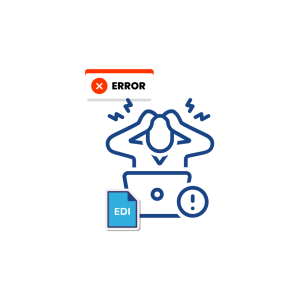Introduction
EDI has often been referred to as the lifeblood of the logistics industry. Implementing a proper EDI solution can do incredible things for the logistics industry. It can improve operational efficiency, increase visibility into the supply chain, and, most of all, strengthen customer relationships throughout the ecosystem.
The EDI in the logistics industry helps manage the documentation for
- Purchase orders
- Bill of lading
- Details of the warehouse
- Shipping details
- Customs documents
- Inventory documents
- Shipping status documents
- Payment documents
- Invoices and advance ship notices

Supply Chain Operations in the Logistics Industry
Here is the list of logistics chain operations that use EDI in the logistics industry. In other words, this is how the data will flow in a normal day-to-day operation in the logistics industry,
- Exporters
- Freight Forwarders
- Customs Broker
- Customs Officer
- Shipping agents/NVOCCs
- Port Operators
Port Operators are the ones that receive the vessels. While the systems in place for each country to transmit data are different, the data required itself is similar in any type of port. The information in question may include: –
- Cargo Manifest
- Discharge List
- Transport Order (Cargo Haulers)
- Customs Control (inspection, collection)
- Declaration of Dangerous Goods
- Equipment Interchange Receipt (EIR)
As mentioned, freight forwarders prepare shipping documents. Immediately, the 3 shipping documents that come to mind are:
- Invoice
- Packing List
- House Bill of Lading
Freight Forwarders use the EDI systems in place to submit a cargo manifest.
A customs broker is an intermediary between the customs officer and cargo owners or freight forwarders. They are tasked with submitting custom declarations for any item imported or exported to and from the country.
The Customs officers receive the information transmitted by the customs broker and the freight forwarder. Then customs officer uses the transmitted EDI information in order to run risk assessments on the cargo transported.
Shipping Agents and NVOCCs submit shipping manifests to port operators and customs officers
Port Operators are the ones that receive the vessels. While the systems in place for each country to transmit data are different, the data required itself is similar in any type of port. The information in question may include: –
- Cargo Manifest
- Discharge List
- Transport Order (Cargo Haulers)
- Customs Control (inspection, collection)
- Declaration of Dangerous Goods
- Equipment Interchange Receipt (EIR)
Why it’s Important to be EDI compliant for Logistics Industries
A recent survey data shows that poor integration overall led to 14% of companies losing $1 million or more in 2021, and nearly 1 in 4 lost $500,000 or more
Logistics companies that aren’t EDI compliant will soon realize how quickly fines can add up. Going one step further, besides costing your company money, non-compliance impacts the trust companies have built with trading partners, jeopardizing those relationships, and lowering the competitive threshold.
How to Get Started With EDI in the Logistics Industry
Here are the steps to get started with EDI,
Step 1: Understand EDI Standards
You as a business need to understand what standards apply to your shipping company so that you can use EDI effectively. There are two main standards used today: ISO 20022 (EDIFACT) and EDI ANSI X12 Standard.
Step 2: Setup Your EDI Solution
Identify whether you want to build your own in-house EDI solution or want to use managed EDI services from 3rd party provider. Once you’ve set up your EDI solution, you’ll need to add your customers and vendors to the system. This will allow your shipping company to automatically send and receive EDI documents electronically.
Step 3: Create Your EDI Document Templates
You can use EDI templates to make sure your shipping company has everything it needs to process orders quickly and efficiently. If you’re using a third-party service provider, ask them what kind of template they need to work with.
Step 4: Start using Your EDI Solution
Now you can automate your entire data exchange process with your business partners. It’s easy to set up, and once you do, you won’t ever have to worry about manually entering data again.
Benefits of Using EDI in the Logisitics Industry
The Electronic Data Interchange (EDI) allows companies to exchange information electronically between each other, which helps reduce paperwork and costs associated with paper documents.
Here are eight reasons why it’s worth considering
1. Reduce Costs
EDI is an electronic data interchange (EDI) system used by shippers to exchange information with carriers and other parties involved in the transportation process. It allows companies to share information electronically instead of manually entering data into paper forms. This saves time and money.
2. Increase Efficiency
EDI also helps businesses save time and money by increasing efficiency. By using EDI, shippers can automate processes such as invoicing, tracking shipments, and receiving payments. They can also use EDI to track inventory and manage customer orders more efficiently.
3. Eliminate Errors
EDI allows companies to eliminate errors and reduce costs. It also improves customer service because customers receive accurate bills and invoices.
4. Streamline Operations
EDI helps streamline operations by reducing manual data entry and eliminating errors. This reduces the need for human intervention, which means less time spent processing paperwork and more time spent doing what matters most – serving customers.
5. Access information in Real time
The introduction of EDI in the shipping industry is considered a boon in many ways. One of them is accessing real-time information. This helps avoid possible delays in sending or receiving data/documents.
6. Integrated communication system
Thanks to the EDI, you can now have an integrated communication system in place for all your shipping operations. The one communication flow ensures traceability, integrated transactions such as purchase orders, order receipts, invoices, pending payments, and more.
7. Environment-friendly
EDI reduces 99.99% of paperwork required in your business
you can save a few dollars otherwise spent on:
- Buying paper
- Postal service
- Document storage
- Loss-proof documentation
- Improve customer service
8. Improve trading partner relations
EDI helps you to communicate with your trading partners swiftly. Unlike paper documentation which takes more time to convey a message
Conclusion
The integration of Electronic Data Interchange (EDI) in the logistics industry marks a transformative shift towards enhanced efficiency, accuracy, and collaboration. By facilitating the seamless exchange of critical documents such as bills of lading, invoices, and shipping notices, EDI streamlines logistics processes, reduces manual errors, and accelerates the flow of information across the maritime supply chain. As the shipping industry embraces digitalization, EDI emerges as a cornerstone technology, fostering a more connected, transparent, and agile global shipping ecosystem.
Ready to find out more about Commport EDI Solutions Designed for Logistics Industry?
Need Help? Download: EDI Buyers Guide
Unlock the full potential of your supply chain with our comprehensive EDI Buyer's Guide — your first step towards seamless, efficient, and error-free transactions
Frequently Asked Questions
EDI plays a crucial role in the logistics industry by enabling the electronic exchange of documents like bills of lading, invoices, and shipping notices. It streamlines communication, reduces paperwork, and enhances overall efficiency in logistics processes.
EDI benefits shipping companies and logistics providers by automating document exchange, minimizing errors, improving data accuracy, and accelerating the processing of critical information. It contributes to streamlined operations and increased collaboration among stakeholders.
Yes, EDI facilitates communication between various entities in the maritime supply chain. Shipping companies, ports, customs authorities, and other stakeholders can exchange standardized electronic documents seamlessly, promoting interoperability.
Yes, EDI can be configured to comply with international shipping standards. It is adaptable to various industry standards such as UN/EDIFACT or ANSI X12, ensuring compatibility with global trading partners and regulatory requirements.
EDI contributes to sustainability by reducing paper usage, minimizing manual processes, and optimizing logistics efficiency. The streamlined communication it enables helps in lowering the environmental footprint of shipping operations.





